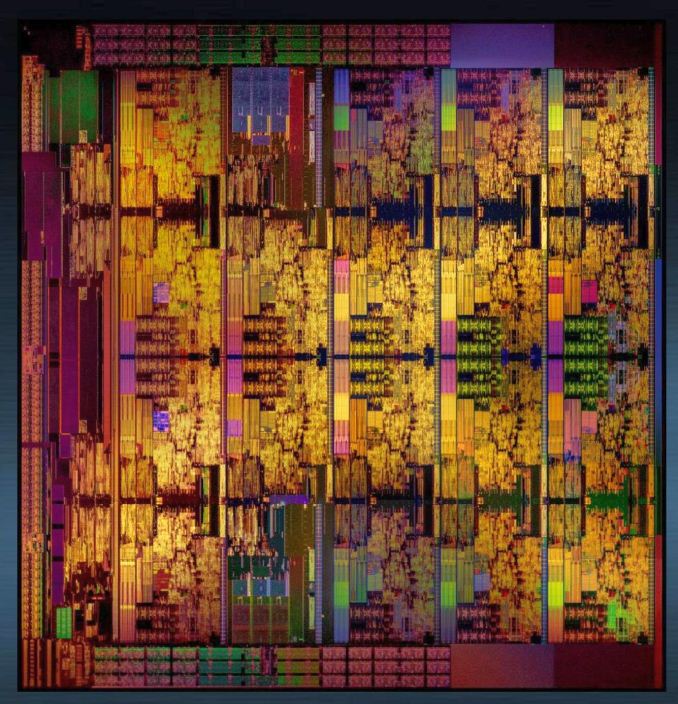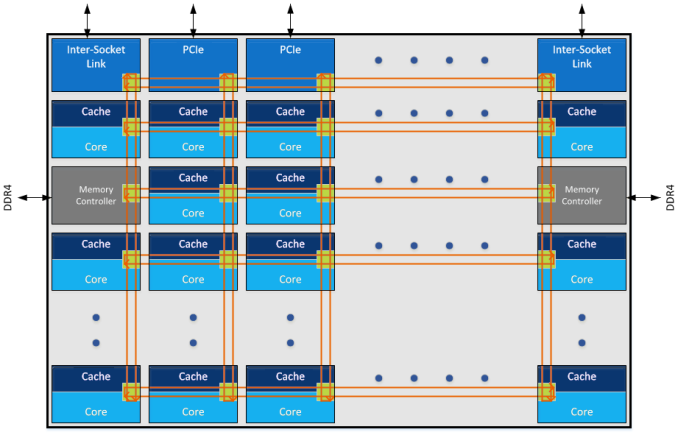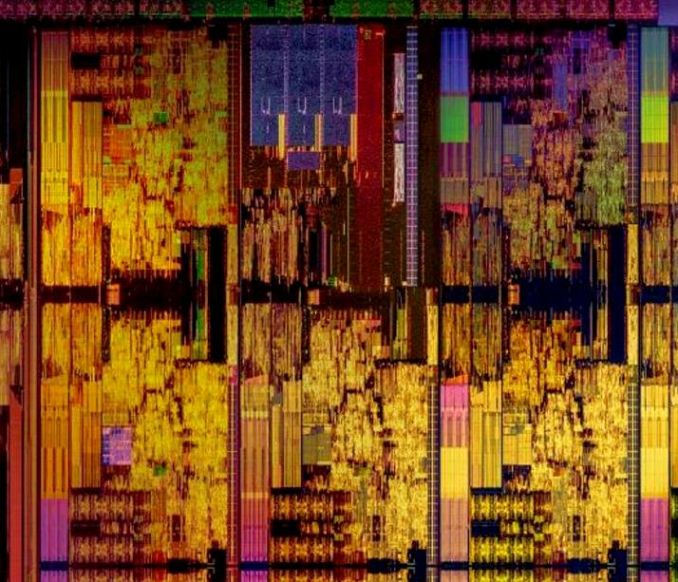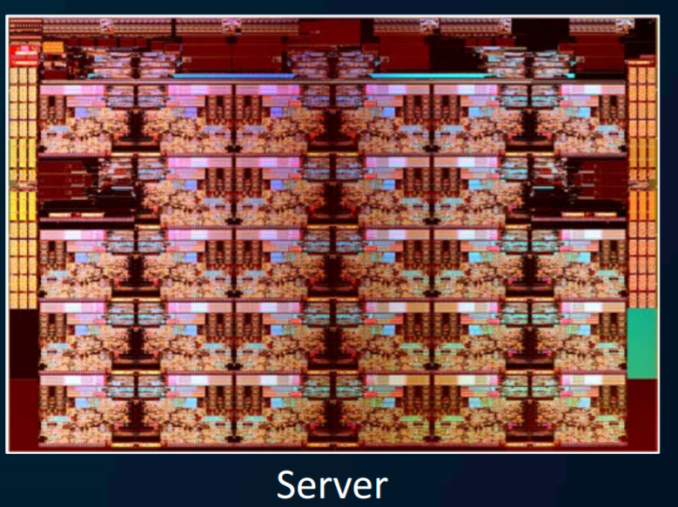The Intel Skylake-X Review: Core i9 7900X, i7 7820X and i7 7800X Tested
by Ian Cutress on June 19, 2017 9:01 AM ESTDie Size Estimates and Arrangements
On the previous page, we showed pictures of ring bus and mesh arrangements. With a ring bus, ultimately the silicon layout of the cores and the interconnects can be regular but are not that stringent. Put the cores in a circle (or overlapping circles) and away you go. With a mesh, things get a little more rigid.
The mesh diagrams on the previous page are all presented as rectangles in x*y arrangements. You either have to add a full row or a full column to increase the die count, whereas in a ring it could be straight forward just to add another pair of cores into the ring (which is what happened over the last few generations). Adding a pair of cores in a mesh means that you end up with more corners and more edges – not all cores end up ‘equal’ and there can be performance penalties therein. Ideally, an arrangement where x = y is usually the best bet. This lets us make some predictions about how Intel’s silicon is lining up.
A side-note for discussion. If we had a 100x100 core arrangement, the cores in the middle would have big latency to get anywhere near external memory. Also, a 2D mesh could become a 3D mesh.
Three things come to our aid in discussing the LCC and HCC silicon. First was the original Skylake-X announcement back at Computex: one of Intel’s slides had an image of the basic floorplan of the HCC silicon to be used for the high core-count Skylake-X processors:
At the time, we were a bit stumped by this image. By counting the regular structures, we can see 4x5 arrangement, or rather a 20-core chip. On closer inspection two of the cores were different: on the second column, the top and bottom ‘cores’ did not look like cores. At the time we postulated that given the size of AVX512, this might be where they were. But the second piece of information was given through Intel’s mesh announcement.
Here’s the diagram:
This is meant to be a pseudo mockup of a theoretical core of n processors using the mesh topology. At the top are the socket links, along with the PCIe root complexes. However on the left and right are the DRAM controllers, essentially taking up the same area as a core but also using one of the mesh networking links.
So scoot back to that HCC die image, and zoom in on one of those odd looking ‘cores’:
What we can see is three regular blue/green vertical areas, which means three on each side, for a total of six. Skylake-X only has four memory channels, but leaks have shown that the new Skylake-SP processors have six memory channels by design, so here they are. In the 4x5 grid, we have 18 cores and two sets of memory channels.
Back when Skylake-X was announced at Computex, I wrote that we were expecting the LCC silicon to be a 12-core design. At this time, we were still expecting Intel to use a ring-bus topology, and I mentioned before, adding two cores to a ring bus is fairly easy at the expense of peak latency between cores. Now that we know that Intel is using a mesh, it is quite different.
12 cores could quite easily fit into LCC silicon in a 3x4 arrangement, but that does not leave any room for the six memory controllers that the enterprise Xeons are all meant to have. If we added two ‘extra’ core sized areas for the 12-core design, we need a total of 14 segments. Using the x*y arrangement as required above, the only way 14 cores works is using a 7*2 arrangement. If this was the case, the DRAM controllers would essentially fill a whole row, or be at opposite ends of the column. If one of the x*y numbers is the number two, it makes more sense to use a ring bus any day of the week for power, die area and simplicity.
So that means that the 12-core SKU, the Core i9-7920X, is likely derived from the HCC 18-core silicon. Which also explains why that CPU has been delayed until August.
Die Sizes
At this point in time, the Skylake-X processors based on the LCC silicon have been in the hands of a few people. At Computex there were several extreme overclocking (using sub-zero coolants) events dedicated to the new processors. One element of recent extreme overclocking is delidding the processor and removing the integrated heat spreader to replace the thermal interface material underneath.
In general removing the IHS is not recommended without practice and experience, but for some processors in the past we have seen sizeable temperature benefits by replacing the standard thermal interface material (TIM) that Intel uses. The discussion on whether Intel should be offering a standard goopy TIM or the indium-tin solder that they used to (and AMD uses) is one I’ve run on AnandTech before, but there’s a really good guide from Roman Hartung, who overclocks by the name der8auer. I’m trying to get him to agree to post it on AnandTech with SKL-X updates so we can discuss it here, but it really is some nice research. You can find the guide over at http://overclocking.guide.
However removing the IHS means we can measure the silicon die.
The 10-core LCC die, which is a 3x4 design, measures in at 14.3 x 22.4, or 322mm2.
Using this, working from Intel’s 4x5 HCC diagram (and assuming it hasn’t been stretched), we can get 21.6 x 22.4 = 484mm2 for the high-core count design.
That leaves the Extreme core count option. Using the x*y strategy again, Intel could either run a 5x5 design, which gives 25 areas and 23 cores – which is unlikely. Next up is a 5x6 design, which gives 30 areas and 28 cores. It’s no secret that many leaks are pointing to a 28-core XCC processor at this point.
There’s also the fact that Intel provided this die shot at the Intel Manufacturing Day a few weeks ago, clearly showing the 5x6 arrangement:
Doing the basic math on a 5x6 design gives us a 21.6 x 32.3 = 698mm2 die size for XCC.
| Skylake-SP Die Sizes | |||
| Arrangement | Dimensions (mm) |
Die Area (mm2) |
|
| LCC | 3x4 (10-core) | 14.3 x 22.4 | 322 mm2 |
| HCC | 4x5 (18-core) | 21.6 x 22.4 | 484 mm2 |
| XCC | 5x6 (28-core) | 21.6 x 32.3 | 698 mm2 |
Compared to other chips with Intel’s mesh architecture, Knights Landing comes in at 646mm2 (minus MCDRAM), and sources put Knights Corner at 720mm2.














264 Comments
View All Comments
jjj - Monday, June 19, 2017 - link
The 10 cores die is clearly 320+mm2 not 308mm2. The 308mm figure rounds down the mm based on those GamerNexus pics. From there, you slightly underestimate the size of other 2 die.Sarah Terra - Monday, June 19, 2017 - link
Fair point but what I take from this review is that you are going to be spending pretty much double the cost or higher of ryzen for a proc that will have a 30% larger power envelope if you want higher performance. Intel is scrambling here, well done AMD.jjj - Monday, June 19, 2017 - link
With 8 cores and up, thermal is a big issue when you OC Skylake X.. Power also to some extent.The 6 cores looks interesting vs the 7700k but not so much vs anything else. CPU+mobo gets you north of 600$ and that's a lot. If it had all the PCIe lanes enabled, there would be that but ,while plenty will buy it, it makes no sense to. And ofc there should be a Coffee Lake 6 cores soon , we'll see how it is priced- in consumer 6 cores with 2 mem chans is fine.
More than 6 cores are priced way too high and , if you need many cores, you buy for MT not ST so ST clocks are less relevant.
Intel moving in the same direction as AMD on the cache size front is interesting- larger L2 and smaller L3. Now they have "huge cache and memory latency issues"" just like Ryzen lol.
W/e, Intel's pricing is still far too high and this platform remains of minimal relevance.
ddriver - Monday, June 19, 2017 - link
Funny thou, when Ryzen under-performed in games that was no reason to not publish gaming benches, in fact being the platform's main weakness there was actually emphasis put on that... but when it comes to intel we gotta have special treatment... Let's hear it for objectivity!Granted the 7800X finally brings something of relatively decent value, but still no good reason to justify the purchase unless one insists on an intel product, for the brand, for thunderbolt or hypetane support.
"To play it safe, invest in the Core i9-7900X today."
Really? With Threadripper incoming in a matter of weeks? For less than 1000$ you will get 16 zen cores. It will definitely beat the 7900X by a decent margin in terms of performance, plus the massive I/O capabilities and also ECC support, which I'd say is vital. That just doesn't sound like a honest recommendation. Not surprising in the least.
ddriver - Monday, June 19, 2017 - link
Also, on top of that we have launch prices for Ryzen rather than current prices. Looks like a rather open attempt to diminish AMD's platform value.Ian Cutress - Tuesday, June 20, 2017 - link
We've always posted manufacturer MSRPs in our CPU charts. There has been no official price drop from AMD; if you're seeing lower, it's being run from the distributor level.On the TR issue, we basically haven't tested it and don't know the price. Lots of variables in the air, which is why the words are /if you want to play it safe/. Safe being the key word there.
ddriver - Tuesday, June 20, 2017 - link
Dunno Ian, in my book this sounds more like hasty than safe. The safe thing would be to wait out. Even without the incipient TR launch, early adoption is rather unsafe on its own. As it is, it sounds more like an attempt to dupe people into spending their money on intel in the eve of the launch of a superior value and performance product from a direct (and sole) competitor.It is true that nothing is still officially known about TR, but based on the ryzen marketing strategy and performance we can make safe and accurate speculations. I expect to see the top TR chip launched at 999$ offering at the very least 30% of performance advantage over the 7900X in a similar or slightly higher thermal budget, of course in workloads that can scale nicely up with the core count.
Comparing the 7900X to the 1800X, we have ~35% performance advantage for 205% the price and 150% the power usage. Based on that, it is a safe bet that TR is going to shine.
fanofanand - Monday, June 26, 2017 - link
Ian is a scientist, the less guessing the better. Give him an opportunity to review TR before giving suggestions. Doesn't that seem fair?t.s - Tuesday, June 20, 2017 - link
Play it safe? Really?? Please. As if everyone in this world's stupid.Ranger1065 - Wednesday, June 21, 2017 - link
There has never been a better time to give Intel the middle finger.